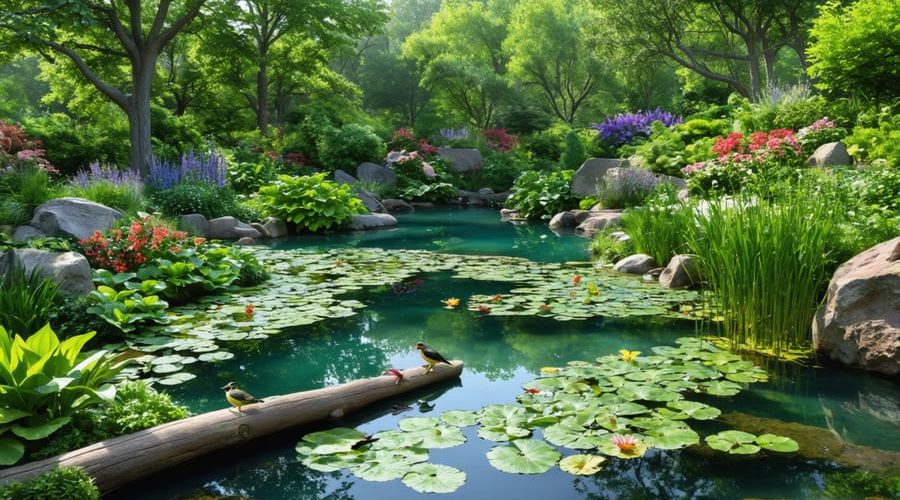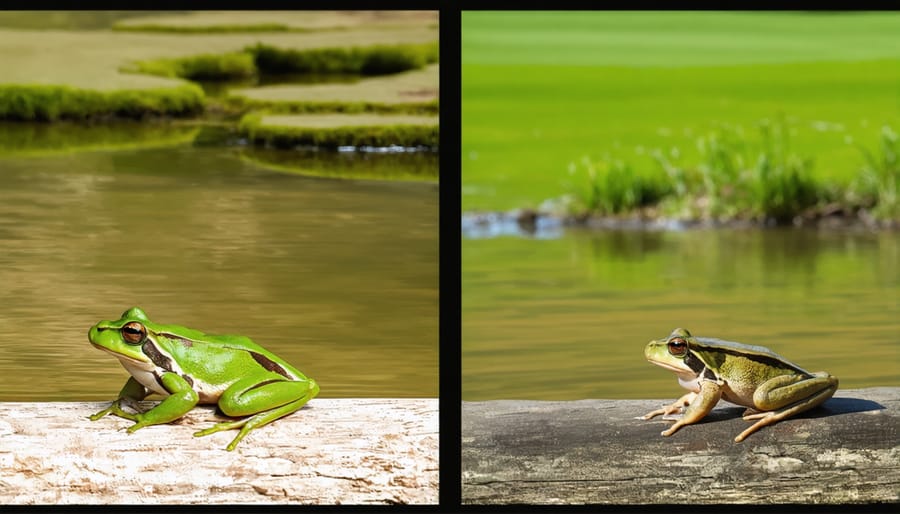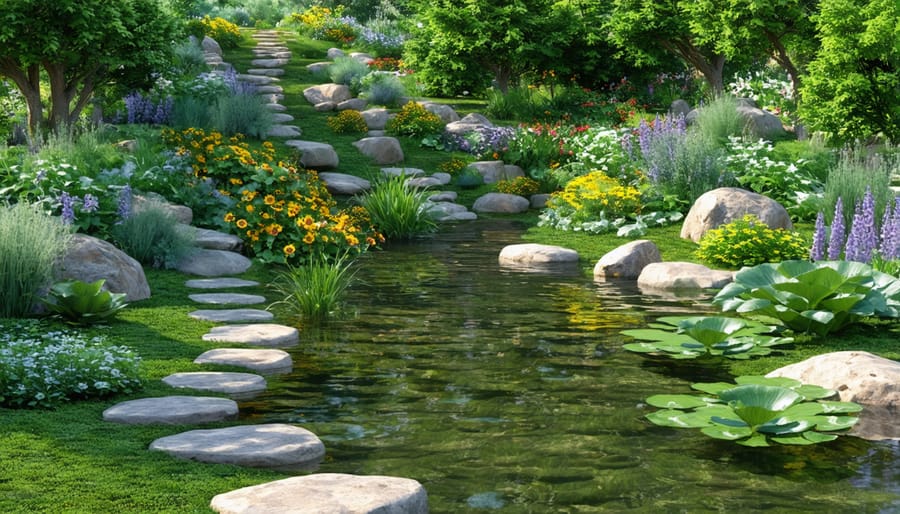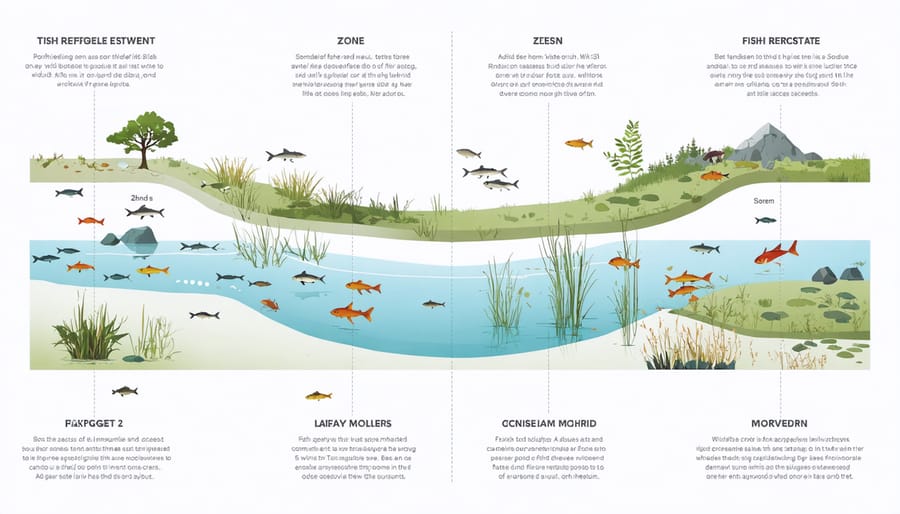
Natural Wildlife Corridors: Make Your Pond a Thriving Ecosystem Hub
Transform your backyard into a thriving wildlife corridor by creating strategic connections between natural habitats. Linking ponds, gardens, and green spaces enables animals to move safely through urban landscapes, access vital resources, and maintain genetic diversity. A well-designed balanced pond ecosystem serves as a crucial stepping stone, providing shelter, food, and water for local wildlife while strengthening the broader ecological network in your neighborhood. By incorporating native plants, shallow water zones, and natural cover, your pond becomes more than just a water feature—it’s an essential link in the chain of wildlife connectivity that helps local species thrive despite urban development and habitat fragmentation.
Understanding Wildlife Connectivity in Garden Ponds
The Wildlife Highway: Land-to-Water Transitions
Just like highways connect different neighborhoods, wildlife needs safe paths between land and water. These transition zones, often called riparian areas, are crucial meeting points where terrestrial and aquatic worlds blend together. In your pond, these areas can be as simple as gently sloping banks or strategically placed rocks that create easy access points.
Think of these transitions as wildlife-friendly ramps. Amphibians like frogs and salamanders need to move between water and land throughout their lives. Small mammals such as hedgehogs and rabbits require safe access to drink, while birds appreciate shallow areas for bathing and drinking. Even insects like dragonflies depend on plants that bridge these two environments.
Creating effective land-to-water transitions doesn’t need to be complicated. Varying the pond’s depth with shallow margins, adding partially submerged logs, and maintaining native plants along the edges all help create these natural highways. Remember to keep some areas of your pond edge clear of thick vegetation – this provides essential access points while maintaining visibility for cautious wildlife visitors.
These transition zones not only support wildlife movement but also help filter runoff, prevent erosion, and enhance your pond’s natural appearance.

Key Species That Bridge Environments
Several fascinating creatures regularly move between water and land environments, making them essential for connecting pond ecosystems with the surrounding landscape. Frogs and toads are perfect examples, starting life as aquatic tadpoles before developing into land-dwelling adults that return to water for breeding. Salamanders follow a similar pattern, while dragonflies spend their larval stage in water before emerging as aerial hunters that patrol both pond edges and nearby gardens.
Many birds act as natural bridges between environments too. Herons and kingfishers dive for fish but nest in trees, while songbirds visit ponds for drinking and bathing before returning to nearby shrubs and gardens. Even some mammals, like raccoons and deer, regularly move between water sources and surrounding areas, helping spread native plant seeds in the process.
These species don’t just use both environments – they actively contribute to ecosystem health by transferring nutrients, pollinating plants, and controlling pest populations. By understanding and supporting these natural connections, pond owners can create more vibrant and sustainable backyard habitats that benefit both wildlife and gardens.

Creating Safe Passages for Pond Wildlife
Shallow Areas and Beach Entry Points
Creating gentle slopes and easy access points in your pond is crucial for wildlife connectivity, making it welcoming and safe for various creatures. A well-designed beach entry not only looks natural but serves as a vital transition zone between land and water.
Start by planning a gradual slope ratio of 1:3 (one foot of depth for every three feet of horizontal distance). This gentle incline allows animals to enter and exit safely while preventing erosion. When constructing your beach entry, use a mix of different-sized rocks and gravel, starting with larger stones at the bottom and progressively smaller ones toward the shore.
Consider creating multiple access points around your pond, particularly on the sides that face natural wildlife corridors or existing habitats. These entry points should feature non-slip surfaces – rough-textured stones work well for this purpose. Adding partially submerged logs or flat rocks near the water’s edge provides convenient resting spots for amphibians and reptiles.
For shallow areas, aim to maintain depths between 2-6 inches near the edges, gradually deepening toward the center. These varying depths create different microhabitats that support diverse wildlife. Plant marginal vegetation in these shallow zones to provide cover and natural footing for visiting creatures.
Remember to maintain these areas regularly by removing excess debris and checking for damage, especially after storms. However, don’t over-clean – some plant matter and natural debris actually help create beneficial microhabitats.
A thoughtfully designed shallow area with proper beach entry points transforms your pond from a simple water feature into a thriving wildlife highway, connecting various species to vital water resources while maintaining the aesthetic appeal of your garden.
Plant Corridors and Cover
Creating natural corridors with plants is one of the most effective ways to support wildlife movement in your backyard pond area. By using vegetation to create pathways, you provide safe routes for creatures to travel between different water features and habitat zones.
Start by planting taller grasses and native shrubs around your pond’s edges, gradually extending outward to connect with other garden features. This creates a protective tunnel effect that smaller animals like frogs, lizards, and beneficial insects can use to move safely. Layer your plantings with different heights – ground covers, mid-height perennials, and taller bushes – to accommodate various wildlife species.
Consider creating “stepping stone” patches of dense vegetation every few meters if you can’t maintain continuous coverage. These islands of plants still provide refuge points for wildlife on the move. Native plants work best as they’re already adapted to local conditions and naturally attract native wildlife.
Don’t forget to include some evergreen plants in your corridor design. These provide year-round cover and ensure wildlife can safely navigate your garden even during winter months. Mix in flowering plants too – they’ll attract pollinators and create additional food sources along the travel routes.
Remember to maintain some open spaces between plantings. While cover is important, many creatures also need clear sight lines to watch for predators. A mix of dense vegetation and small clearings creates the ideal balance for wildlife movement while keeping your garden looking naturally beautiful.
Balancing Fish and Wildlife Needs
Safe Zones for Different Species
Creating designated safe zones in your pond is essential for different wildlife species to thrive together harmoniously. Think of these zones as individual neighborhoods where different creatures can feel secure and comfortable.
Start by establishing shallow areas with graduated depths, ranging from 2-6 inches deep. These gentle slopes are perfect for small amphibians, birds, and insects to access the water safely. Add flat rocks around these areas to create basking spots for frogs and turtles.
In deeper sections (2-3 feet), create fish refuges using submerged rocks, hollow logs, or aquatic plants. These hiding spots are crucial for fish to escape predators and provide safe spaces for laying eggs. Dense vegetation clusters work wonderfully as natural barriers between different zones.
Don’t forget to include some dry land areas! Create small islands or partially submerged logs to serve as connection points between water and land. These transition zones are particularly important for salamanders and newts that need both environments to complete their life cycles.
For smaller creatures like beneficial insects, incorporate floating plants and dense marginal vegetation. These plants offer protection and serve as natural resting spots. Remember to maintain some open water areas too – this balance ensures that all species can move freely while having access to their preferred safe spaces.
By thoughtfully designing these different zones, you’re creating a mini-ecosystem where various wildlife can coexist peacefully while supporting the overall health of your pond.

Managing Predator-Prey Relationships
Creating a balanced ecosystem in your pond means understanding and managing predator-prey relationships effectively. To protect your fish while still welcoming beneficial wildlife, consider installing protective shelters like floating plants or submerged caves where fish can quickly hide from predators. Pond netting can be particularly useful during seasons when herons and other fish-hunting birds are most active, while still allowing smaller wildlife to access your pond.
Create different depth zones in your pond, with some areas being at least 4-5 feet deep. These deeper sections give fish a safe retreat while maintaining shallow areas where beneficial creatures like frogs and dragonflies can thrive. Consider adding strategic rock piles or hollow logs near the water’s edge to provide refuge for both aquatic and terrestrial wildlife.
Motion-activated sprinklers can serve as a humane deterrent for larger predators without harming them or disturbing the overall ecosystem. Remember to maintain clear sight lines around your pond, trimming back dense vegetation where predators might hide while stalking fish. This balanced approach helps protect your pond inhabitants while still keeping your water garden an attractive destination for beneficial wildlife that contributes to its natural health and beauty.
Seasonal Considerations for Wildlife Access
Winter Access Points
During the winter months, maintaining wildlife connectivity becomes especially crucial as animals face challenges accessing water and moving between habitats. Creating and maintaining winter access points isn’t just about keeping holes in the ice – it’s about providing safe, reliable pathways that wildlife can count on throughout the cold season.
The most important winter access feature is maintaining at least one ice-free spot in your pond. A pond aerator or de-icer can help keep a small area open, allowing animals to drink and water birds to land. Position these openings away from steep banks to prevent accidents, and consider adding gently sloping rocks or branches that provide easy entry and exit points.
Don’t forget about the approaches to your pond. Winter can create slick conditions, so maintaining cleared paths through snow and ice helps animals reach the water safely. Natural materials like hay, straw, or fallen branches can create protected corridors that smaller creatures use to travel between sheltered areas and water sources.
Remember to check your access points regularly throughout winter. After snowstorms, clear any drifts that might block established pathways. Also, ensure that any equipment maintaining ice-free areas is functioning properly – wildlife quickly comes to depend on these reliable water sources when natural alternatives freeze over.
Keep artificial lighting to a minimum around these access points, as excess light can disorient nocturnal visitors and make them more vulnerable to predators.
Breeding Season Adaptations
Spring and summer bring exciting changes to your pond’s wildlife connectivity, as local creatures become more active during their breeding seasons. During these months, it’s essential to provide safe passage and nesting areas for various species while maintaining your pond’s beauty and functionality.
Create gentle slopes around your pond’s edges to help amphibians like frogs and salamanders easily move between water and land. These slopes also benefit baby ducklings and other waterfowl that might visit your pond. Install partially submerged logs or floating platforms to give turtles safe spots for basking and resting between their breeding activities.
Consider adding native plants around your pond’s perimeter to create natural corridors for wildlife movement. Tall grasses and shrubs offer protective cover for small animals traveling to and from the water, while also providing nesting materials for birds. Leave some areas of longer grass unmowed during breeding season to create safe havens for ground-nesting birds and small mammals.
Be mindful of your maintenance routine during these crucial months. Avoid heavy pruning or major pond work between March and July when most animals are breeding. If you must perform maintenance, carefully check for nests or animal activity before starting any work. Consider installing wildlife-friendly lighting that won’t disturb nocturnal breeding activities, and maintain water quality without harsh chemicals that could harm developing eggs or young animals.
Creating wildlife connectivity in your pond isn’t just about building a beautiful water feature – it’s about being part of something bigger. By implementing the strategies we’ve discussed, you’re creating vital stepping stones for local wildlife and contributing to the health of your entire ecosystem. Remember, even small changes like adding native plants, creating gentle slopes, or maintaining wildlife corridors can make a significant difference.
The key is to start with what you can manage and gradually expand your efforts. Whether you’re adding a few carefully chosen plants to increase pond biodiversity or redesigning your entire garden space, every step matters. Consider your pond as part of a larger network of habitats, connecting with neighboring gardens and natural areas.
Don’t feel overwhelmed by trying to implement everything at once. Start with one or two features that excite you most, whether that’s installing wildlife-friendly plants or creating accessible entry points for animals. As you witness more wildlife visiting your pond, you’ll likely feel inspired to do even more.
Remember, a wildlife-friendly pond isn’t just beneficial for local fauna – it creates a more vibrant, sustainable, and enjoyable outdoor space for you too. By embracing wildlife connectivity, you’re not only supporting local ecosystems but also creating a living, breathing sanctuary right in your backyard. Keep observing, learning, and adapting your approach as your pond evolves into a thriving hub of biodiversity.
